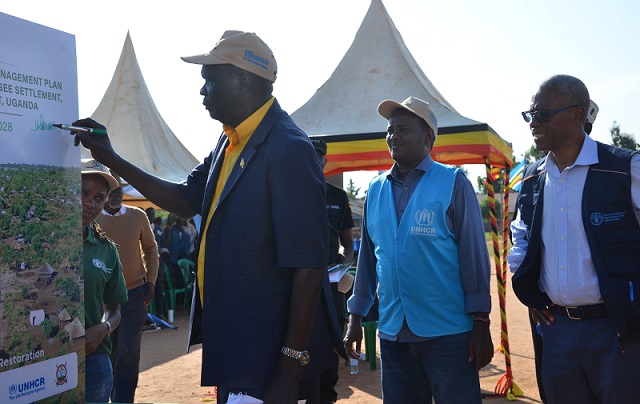
launch the Forest Landscape Management Plan for Bidibidi Refugee Settlement. Looking on are Moulid
Hirsi, the Officer in Charge of UNHCR Yumbe District and Antonio Querido- the FAO Representative in
Uganda. PHOTO/FAO
Uganda designs blueprint based on largest camp at Bidibidi
Kampala, Uganda | RONALD MUSOKE | The Uganda government together with the United Nations High Commissioner for Refugees (UNHCR) and the Food and Agriculture Organization of the United Nations (FAO) have come up with a five year plan to manage forests in and around Bidibidi – the largest refugee settlement in the northwest of the country.
The five year plan (2023-2028) presents guidelines for protecting and maintaining forests and biodiversity in and around Bidibidi Refugee Settlement in West Nile, which hosts over 250,000 refugees.
It focuses on three main strategies; establishment of woodlots for energy, restoration of degraded forest and other land, and the conservation of intact or partially intact natural forests. The beneficiaries of these interventions include both refugee and host communities within the target areas, as well as institutions such as churches, mosques, schools and health facilities.
Starting next year, theUS$10.9 million (Shs40.4 billion)forest landscape management project will seek to conserve 20,054 hectares of natural forests, restore up to 75 hectares of degraded forests, plant 2,786 hectares of woodlots and support agroforestry on 6,771 hectares in and around Bidibidi refugee settlement.
The objective is to sustainably supply fuel wood, timber and non-wood forest products; improve the quality of life of the refugees and host communities and involve everyone in the management of forest resources. Its methods, strategies and interventions have the potential to be replicated in other refugee settlements in Uganda and elsewhere.
Uganda has one of the most exemplary asylum policies in the world and the country presently hosts the largest number of refugees in Africa. Close to about 1.5 million refugees mostly from the Democratic Republic of Congo, South Sudan, and Burundi live in 13 settlements around the country.
Bidibidi refugee settlement in the West Nile sub-region stands out as the largest settlement in the country. The influx of refugees and asylum seekers fleeing conflicts in South Sudan, the Democratic Republic of Congo, Burundi and Somalia have added onto the existing pressure on the environment around Bidibidi and resulted in reduced access and competition with host communities over the use of limited natural resources.
Wood fuels are the main source of energy for cooking for more than 90% of households in Uganda. According to the Uganda Bureau of Statistics, for every three people in Uganda, two rely on either firewood or charcoal for their cooking energy needs.
For refugee communities, the dependence on wood-based cooking energy is even more critical.
For instance, the total annual demand for wood fuel for cooking for the refugees and host communities settled in Bidibidi is estimated at 146,871 tonnes per year.
Bidibidi plan
The plan for Bidibidi Refugee Settlement acknowledges the challenges of using natural resources and provides both short- and long-term solutions for sustainable management of natural resources. It focuses on the demand for wood fuel by both refugee and host populations and shows how that outstrips supply within the settlement and a 5km buffer zone around it.It incorporates recent spatial and non-spatial data and trends in and around Bidibidi.
It also explains how to plant energy woodlots to maximise biomass production in a short period of time by increasing tree density to the optimum growth per unit of area and using fast growing species and short rotation coppice management. It also recommends planting multi-purpose species which offer other benefits besides fuel wood and incentive schemes to help motivate people.
“This plan includes realistic guidelines for UNHCR and partners to further alleviate the pressure on the available natural resources,” said Matthew Crentsil, the UNHCR Country Representative said on Dec.15 while unveiling the plan at Bidibidi Refugee Settlement, Kululu sub county in Yumbe District.
Speaking at the launch, the Minister for Relief, Disaster Preparedness and Refugees; Hilary Onek, commended FAO and UNHCR for collaborating with the government and local leadership.
“Investing in sustainable natural resources management and rural livelihoods is essential for realising harmonious co-existence of refugees and host communities,” he said, “I would like to recommend other refugee settlements and nearby hosting communities to develop their forest landscape management plans.”
“The denvelopment agencies, local governments and partners of the Government of Uganda should take the use of plans such as these, into programming and implementing interventions to protect and restore the environment, especially forests”said Antonio Querido, the FAO Country Representative in Uganda.
This plan will also guide work of United Nations High Commissioner for Refugees (UNHCR), the United Nations’ Food and Agriculture Organization (FAO) and other partners involved in supporting environmental and energy interventions.
Kassim Asiku, the Speaker for Yumbe Local Government thanked FAO and UNHCR and said Yumbe District Local Government reviewed and approved the plan.
“We now ‘own’ and will implement it diligently,” he said, “Tree growing must be a priority for 2023 in all sub counties in Yumbe District.” Bidibidi land to refugees; exemplifying the neighbourliness of the people, and the Government of Uganda.
 The Independent Uganda: You get the Truth we Pay the Price
The Independent Uganda: You get the Truth we Pay the Price


